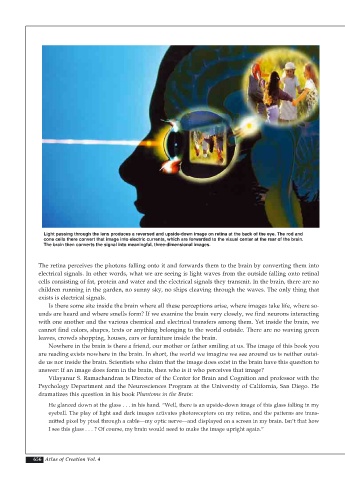Page 658 - Atlas of Creation Volume 4
P. 658
Light passing through the lens produces a reversed and upside-down image on retina at the back of the eye. The rod and
cone cells there convert that image into electric currents, which are forwarded to the visual center at the rear of the brain.
The brain then converts the signal into meaningful, three-dimensional images.
The retina perceives the photons falling onto it and forwards them to the brain by converting them into
electrical signals. In other words, what we are seeing is light waves from the outside falling onto retinal
cells consisting of fat, protein and water and the electrical signals they transmit. In the brain, there are no
children running in the garden, no sunny sky, no ships cleaving through the waves. The only thing that
exists is electrical signals.
Is there some site inside the brain where all these perceptions arise, where images take life, where so-
unds are heard and where smells form? If we examine the brain very closely, we find neurons interacting
with one another and the various chemical and electrical transfers among them. Yet inside the brain, we
cannot find colors, shapes, texts or anything belonging to the world outside. There are no waving green
leaves, crowds shopping, houses, cars or furniture inside the brain.
Nowhere in the brain is there a friend, our mother or father smiling at us. The image of this book you
are reading exists nowhere in the brain. In short, the world we imagine we see around us is neither outsi-
de us nor inside the brain. Scientists who claim that the image does exist in the brain have this question to
answer: If an image does form in the brain, then who is it who perceives that image?
Vilayanur S. Ramachandran is Director of the Center for Brain and Cognition and professor with the
Psychology Department and the Neurosciences Program at the University of California, San Diego. He
dramatizes this question in his book Phantoms in the Brain:
He glanced down at the glass . . . in his hand. “Well, there is an upside-down image of this glass falling in my
eyeball. The play of light and dark images activates photoreceptors on my retina, and the patterns are trans-
mitted pixel by pixel through a cable—my optic nerve—and displayed on a screen in my brain. Isn’t that how
I see this glass . . . ? Of course, my brain would need to make the image upright again.”
656 Atlas of Creation Vol. 4

